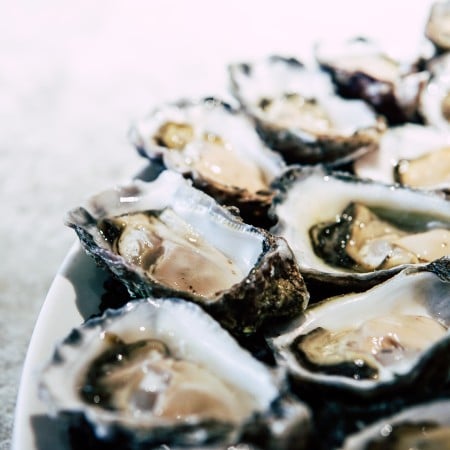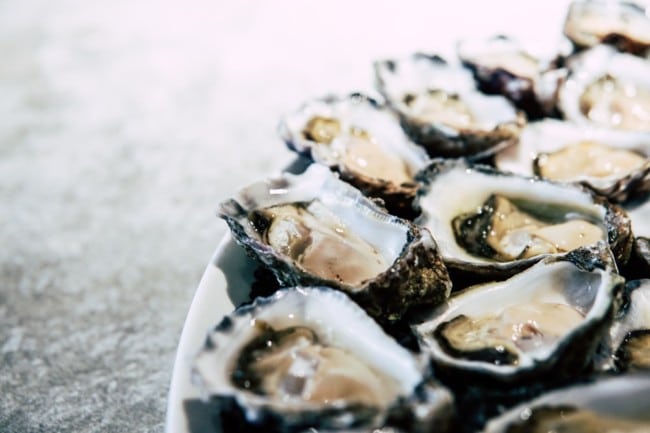For well over 2000 years, the Lenni Lenape people who lived along the Hudson, Hackensack, Raritan, and Delaware rivers made great use of the miles of oyster beds. These oyster beds formed reefs throughout the briny waters where the Atlantic’s salty contribution to freshwater rivers creates estuaries. The coastlines surrounding what is now New Jersey were jagged, lined with mudflat channels and sand bar basins covered in eelgrass. The Lenape gathered oysters from within dugout canoes. Today, piles of oyster shells, called middens, as deep as four feet, are still occasionally found where Lenape settlements once stood, sometimes revealing gravesites. Read on to learn more about how oysters tell a story of our region in New Jersey.

Oysters in Eden
In 1609, the Lenni Lenape referred to Henry Hudson and his Dutch West India Company crew as Shouwunnock (the Salty People), the term they had coined for Giovanni da Verrazano’s crew in 1524 and, perhaps Esteban Gomez and Samuel de Champlain before them. Hudson and his crew referred to Lenapehoking (the Land of the Lenape) as Eden.
For at least the first two centuries after Europeans settled themselves in Lenapehoking, they described the air of the area surrounding the Hudson River as fragrant and fresh, carrying the scent of woodlands, clean streams, and fields of wildflowers. The Dutch, who named what is now New York City, Jersey City, Hoboken, and the surrounding region New Netherlands, delighted in finding oysters as big as a foot long. Like the Lenape, European settlers ate copious amounts of the bivalve mollusks that they recognized as a delicacy, a saleable commodity, and easy insurance against famine. The Lenape taught the European settlers their method of rowing out to sea 15 feet or so from shore and using a long, tong-like rake to pull up the oyster shells that permanently affix themselves to their cultch – the mass of stones, broken shells, and grit of which an oyster bed is formed – by secreting a substance from the foot. The abundance of the oyster reefs appeared impossible to impact.
Oysters spawn in late spring or early summer, hibernate through winter and take about two years to reach full size. The area where the Hudson meets the Atlantic was, until not too very long ago, believed to produce some of the most delicious oysters in the world. Oysters develop a stronger flavor in colder intertidal waters and grow especially well where fresh water draws them rich organic matter.
Read More: A Look Into the History of Ellis Island + Why You Should Visit
The Long Boom Before the Oyster Bust
“I do not weep at the world, I am too busy sharpening my oyster knife.”
– Harlem Renaissance great Zora Neale Hurston, who lived in Westfield NJ with Langston Hughes
Oysters, even when they were cheap enough to buy in mass quantities and use as stuffing, have always been a special treat. Even when oystermen sold their catch unceremoniously on Jersey City street corners to laborers looking for lunch, they were seen as a symbol of decadence. There was such a bounty of oysters in the New York-New Jersey Hudson Estuary — along with clams, and terrapin (turtles that live in brackish water) — that one could lazily pluck a meal from shallow waters to enjoy a movable feast.
But oysters were also an important part of the economy. The shells had long been used for their lime, which was used as a building material and as fertilizer that “sweetened” acidic soil. Shuckers were put to work ten hours a day, six days a week.
The history of oyster culling in New Jersey intersects with that of the Underground Railroad in the form of Thomas and John Vreeland Jackson. The Vreeland Jackson brothers became oystermen on the Hudson in 1830 after gaining their freedom from the family that had held them in slavery. Their oyster business funded the purchase of land and a home through which they bravely helped numerous enslaved people escape to their own freedom.
During the 19th century, free Black men were able to work with some level of autonomy and solidarity in the oyster industry that flourished along the waterfront. The work was not easy. Shucking oysters could mangle hands. Southern Atlantic traditions of using children for this deforming work, because of their small fingers, prompted the passage of labor laws throughout the nation.
By 1881, New Jersey’s intertidal waterfront was lined with packing plants that hired hundreds of full-time shuckers. Trains carried ice-packed containers of raw oysters and jars of pickled oysters to all points west. When New Jersey’s oyster production was at its prime during the decades between 1880 and 1930, the greatest yield came from the lower Delaware Bay, where one to two million bushels of oysters were shipped as far as California annually and thousands of shuckers were employed.
Aquaculture Collapse
Laws to regulate overfishing in New Jersey rivers were passed as early as 1719. They were largely ineffectual. Battles over underwater land rights took place between entrepreneurs who saw the once abundant foodstuff becoming less so. By the time the railroad was hauling away nature’s delectable salty riches, the market was fast demolishing the ecosystem required for the shellfish to thrive.
The coastal marshland habitats that drew fish and sustained the shellfish that had once thrived there, deteriorated quickly during the early 20th century. By the late 1920s, the Hudson River had been so befouled by sewage and industrial waste from factories and oil ships that the Hudson estuary oyster beds had to be closed. It became illegal to collect the contaminated oysters, though that didn’t always stop poachers who were sometimes sickened. In the winter of 1924-1925, the poisonous water led to an epidemic of typhoid fever linked to oyster consumption.
After well over a century of engineering landfill development to reshape and utilize the shore along the Hudson, little to no part of the coastline today resembles what it once looked like in its natural state. Those marshlands that once shed nutrients into the estuary for shellfish consumption and filtered runoff pollutants have long been built over. Dredging and erosion caused sediment and other contaminants to kill off the remaining oyster reefs that weren’t over harvested into extinction. By the 1970s, surveys showed that the great oyster beds of New Jersey had been harvested and poisoned to extinction.
See More: The History of Jersey City’s Former Roosevelt Stadium
The Future is Oysters
Today, oyster aquaculture restoration is looked to as a solution to a number of problems we now face. There are great benefits to developing and protecting living shorelines. Oysters are what is called a keystone species. This special shellfish’s possible role in marine environment recovery is unique.
A single oyster can filter up to 50 gallons of water a day as they feed on plankton. If left undisturbed by mudcover caused by erosion or dredging, their permanent structures create reefs that are as critical to aquaculture as the coral reefs are in tropical and subtropical waters. Marine life thrives among their nooks and crannies, creating vital nurseries for finfish and other shellfish in the brackish waters where ocean and freshwater mix to a perfect point of salinity. These reefs then form natural barriers that have a breakwater effect, protecting the land from extreme weather and the coastal erosion that results in their absence.
Today, programs to build oyster reefs artificially for coastal resilience and healthier ecosystems use a variety of techniques to form oyster beds. Filling metal cages with old clam and oyster shells collected from restaurants is one way to build the framework of such a reef. Stacking concrete oyster “castles” is another. Projects to restore this ecological lynchpin species to the areas once protected by their presence are underway in the Delaware Bay where sea rise is threatening coastal communities.
The fact that oysters filter the water they live in means that they soak up pollutants. For this reason, it is unlikely we will see the formation of oyster reefs in the harbor areas where most of us live. Fear that someone, anyone, might eat a contaminated oyster induced the New Jersey Environmental Protection Agency to ban oyster restoration efforts in waters unsafe to grow commercial shellfish. Further, the dredging required to remove sediment from the harbors and channels used by ferries and other boats would make it impossible for oyster reefs to endure in today’s Hudson estuary. It will take a multifaceted effort to bring back the Eden of our Lenapehoking home.
Content for this article was culled from numerous sources. For a deep dive into the subject, readers will enjoy The Big Oyster: History on the Half Shell by Mark Kurlansky (2006).











